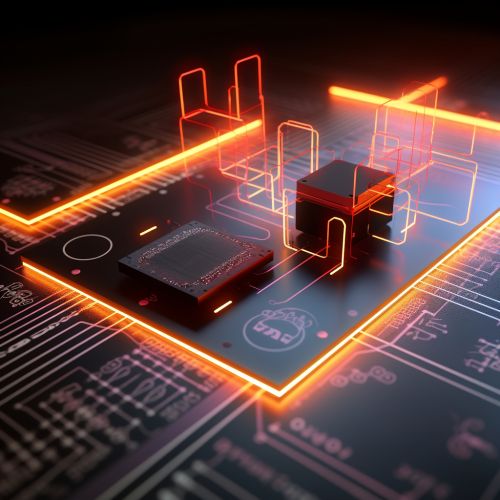Quantum Logic Gates
Introduction
Quantum logic gates are a fundamental building block in the field of quantum computing. Unlike classical logic gates, which operate on classical bits, quantum logic gates operate on quantum bits, or qubits. These gates are the quantum counterparts of classical logic gates and have some unique properties due to the principles of quantum mechanics.


Quantum Bits (Qubits)
Before delving into quantum logic gates, it is crucial to understand the concept of a qubit. A qubit is the basic unit of quantum information, analogous to the bit in classical computing. However, unlike a classical bit that can be either 0 or 1, a qubit can exist in a state that is a superposition of both. This property of qubits is a result of the principle of superposition in quantum mechanics.
Quantum Logic Gates
Quantum logic gates are the building blocks of quantum circuits. They are used to manipulate qubits and perform quantum computations. Quantum logic gates are linear, unitary transformations that operate on one or more qubits. The unitary nature of these gates ensures the preservation of the total probability of the quantum state.
Single Qubit Gates
Single qubit gates operate on individual qubits. Some of the most common single qubit gates include the Pauli-X, Pauli-Y, Pauli-Z, Hadamard, and Phase gates.
Pauli-X Gate
The Pauli-X gate, also known as the NOT gate or bit-flip gate, is the quantum equivalent of the classical NOT gate. It flips the state of a qubit from |0⟩ to |1⟩ and vice versa.
Pauli-Y Gate
The Pauli-Y gate is a more complex quantum gate that applies both a bit flip and a phase flip to a qubit. It is represented by the Pauli-Y matrix.
Pauli-Z Gate
The Pauli-Z gate, also known as the phase-flip gate, flips the phase of a qubit. It leaves the state |0⟩ unchanged and adds a phase of π to the state |1⟩.
Hadamard Gate
The Hadamard gate creates a superposition of states. It maps the basis state |0⟩ to (|0⟩+|1⟩)/√2 and the basis state |1⟩ to (|0⟩-|1⟩)/√2.
Phase Gate
The Phase gate adds a phase of π/2 to the state |1⟩ and leaves the state |0⟩ unchanged. It is also known as the π/2 gate or the S gate.
Two Qubit Gates
Two qubit gates operate on pairs of qubits. The most common two qubit gates are the Controlled NOT (CNOT) gate and the SWAP gate.
Controlled NOT (CNOT) Gate
The CNOT gate performs a NOT operation on the second qubit (target qubit) if the first qubit (control qubit) is in the state |1⟩. If the control qubit is in the state |0⟩, it leaves the target qubit unchanged.
SWAP Gate
The SWAP gate exchanges the states of two qubits.
Quantum Circuits
Quantum circuits are composed of a sequence of quantum gates and are used to perform quantum computations. The computation begins with a set of qubits in an initial state, and the quantum gates are applied in sequence to manipulate the qubits and produce a final state.
Quantum Logic Gate Properties
Quantum logic gates have some unique properties due to the principles of quantum mechanics. These properties include reversibility, superposition, and entanglement.
Reversibility
Quantum logic gates are reversible, meaning that they can be undone by applying the inverse of the gate. This is a result of the unitary nature of quantum gates.
Superposition
Quantum logic gates can operate on qubits in a superposition of states. This allows for parallel computation, which is one of the key advantages of quantum computing.
Entanglement
Quantum logic gates can create entanglement between qubits. Entangled qubits are linked in such a way that the state of one qubit immediately affects the state of the other, no matter the distance between them. This property is used in quantum teleportation and quantum cryptography.
Applications of Quantum Logic Gates
Quantum logic gates are used in various applications of quantum computing, including quantum algorithms, quantum cryptography, and quantum teleportation.
Quantum Algorithms
Quantum algorithms, such as Shor's algorithm for factorization and Grover's algorithm for search, make use of quantum logic gates to perform computations that are significantly faster than their classical counterparts.
Quantum Cryptography
Quantum cryptography uses the principles of quantum mechanics, including superposition and entanglement, to create secure communication channels. Quantum logic gates are used to manipulate qubits in quantum key distribution protocols.
Quantum Teleportation
Quantum teleportation is a process in which the state of a qubit can be transferred from one location to another, without any physical particles travelling the distance. Quantum logic gates are used to entangle and manipulate the qubits in this process.
Conclusion
Quantum logic gates are a fundamental component of quantum computing. They are used to manipulate qubits and perform quantum computations. The unique properties of quantum logic gates, including their ability to operate on superpositions of states and create entanglement, make them a powerful tool in the field of quantum computing.
